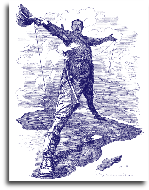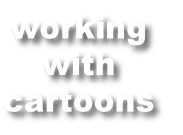










Political cartoons are used to provide a way by which people can express their opinion, comments or criticism. They have always been used to make people think about and discuss events, issues or people.
Cartoonists either want to entertain, to comment about daily life and its problems or to influence the viewer to a particular viewpoint. Cartoons draw attention to and stimulate debate on an idea or an event. They present a point of view and encourage a course of action.
You are often asked to interpret cartoons. In order to do that you must know how to proceed and what elements cartoonists often use.
Symbolism is the use of a sign or object to stand for something other than itself. Exaggeration and distortion: Cartoons do not try to present a picture of reality. Cartoonists exaggerate or understate sizes or distort shapes of objects to stress the cartoon’s meaning. Stereotypes: Cartoonists often use believes, biases and prejudices about specific groups or types of individuals in order to play on our own clichés. Humour is a major element of cartoons. Cartoonists use irony to make a statement that is obviously the opposite of reality. Captions reinforce the cartoon’s non-verbal message.

Describe the cartoon:
- What people and objects can you see in the cartoon?
- What details are used to describe people and objects?
- What objects or physical features are exaggerated or distorted?
- What symbols are used and what do they mean?
- What important words, places and numbers are given?
- What is happening in the different parts of the cartoon?
- What are the speech or thought bubbles about?
- What additional information is given in the title or captions?
- What information is given about its origin and publication?
Analyzing and interpreting the cartoon:
- What political or social topic, event or idea is presented?
- What is the cartoonist’s viewpoint on this issue?
- Who might agree or disagree with the cartoon?
- What information do you have that is relevant to the cartoon?
- What is your opinion about the cartoon?
Political cartoon interpretation - Dealing with a cartoon - Analyzing cartoons
The cartoon shows… — The cartoon has a/no caption… — In the cartoon you can see… — In the foreground/centre/background of the cartoon… — On the left…/In the top right-hand corner you can see… — On the right/on top/at the bottom there is/are… we can see… — The scene depicts… — X is characterized as someone who…
The cartoon/cartoonist makes fun of… - criticizes… - has a critical attitude towards… - points out (that)… - tries to show… - wants to remind us of… - seems to suggest that… — The cartoonist emphasizes the idea that… - illustrates… - wants to express the fact that… — The cartoon epitomizes… - conveys the message that… — The cartoon is a reference to… - refers to… - is a criticism of… — The message of the cartoon is… — To get across the message, the cartoonist…
I firmly believe that… - I think... - It’s my opinion that… - In my opinion… - I agree with… - From my point of view… — As far as I am able to judge… - There is no doubt in my mind that… — I agree in principle, but… - I have my doubts as to… — I respect the cartoonist’s opinion, however… - I can’t share the cartoonist’s point of view because… - I totally disagree with the cartoonist …


